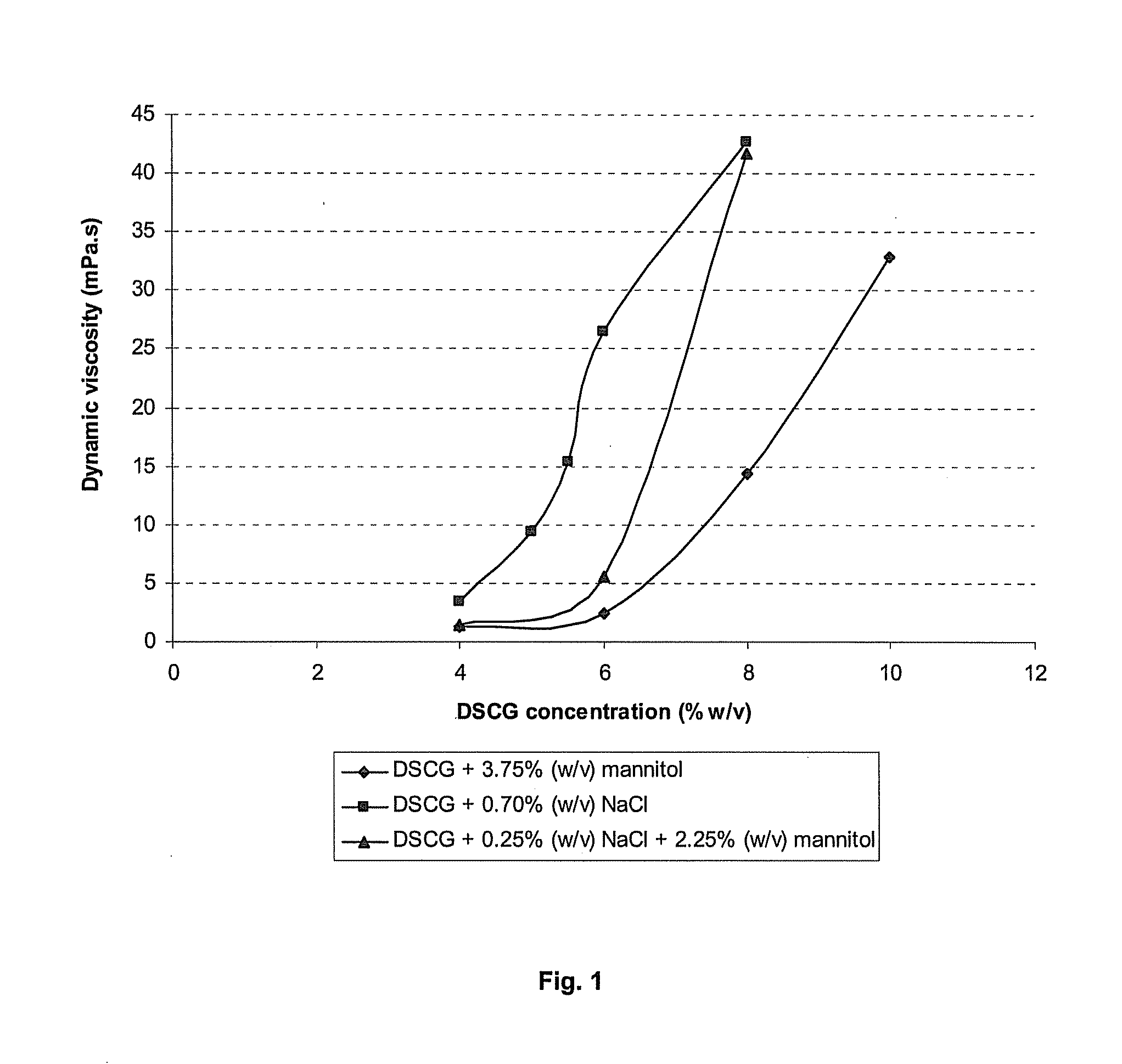Concentrated mast cell stabilizing pharmaceutical formulations
a technology of mast cell and pharmaceutical formulation, applied in the direction of drug composition, dispersed delivery, inorganic non-active ingredients, etc., can solve the problems of increasing the relative risk of certain conditions, osteoporosis, and severe viral infections in infants, and achieve favorable aerosolisation properties
- Summary
- Abstract
- Description
- Claims
- Application Information
AI Technical Summary
Benefits of technology
Problems solved by technology
Method used
Image
Examples
example 1
[0104]The following example shows the influence of the presence of ions (in the form of sodium chloride) on the viscosity of DSCG solutions. The example is for comparison.
[0105]4% DSCG solutions containing increasing concentrations NaCl were prepared. The concentrations are shown in Table 1. In all cases, DSCG was weighed together with sodium chloride and dissolved in water for injection. The dynamic viscosity of the samples was measured at room temperature immediately after preparing the samples with a rotational viscometer. As shown in Table 1, the dynamic viscosity increased strongly for increasing NaCl concentrations.
TABLE 1Dynamic viscosity of DSCG solutions containingincreasing concentrations of sodium chlorideDSCGNaClNaClDynamicFormu-concentrationconcentrationconcentrationviscositylation(% w / v)(% w / v)(mol / l)(mPa · s)14.00.00.0001.1224.00.50.0861.4034.00.90.1543.4944.01.50.25727.0654.02.00.34260.9664.03.00.513143.39
example 2
[0106]In this example, the influence of an increasing DSCG concentration and the type of tonicity-adjusting excipient on the dynamic viscosity of the resulting solution is shown. Table 2 displays the composition of the formulations containing various concentrations of DSCG and various excipients, together with their dynamic viscosity. All solutions were prepared by weighing the active agents and excipients and dissolving these compounds in water for injection. The solutions were sterile filtered and filled in glass vials closed with Teflon-coated stoppers. It is apparent that the increased dynamic viscosity is linked with increasing drug concentrations and increasing ionic excipient concentrations.
[0107]FIG. 1 further illustrates that the dynamic viscosity of DSCG solutions increases strongly upon increasing the DSCG concentration. The addition of an ionic tonicity-adjusting agent (sodium chloride) increases the dynamic viscosity even stronger. Replacing part of the ionic tonicity-a...
example 3
[0108]In this example, the influence of another sodium salt on the viscosity of a DSCG solution is demonstrated. A first solution was prepared containing 6.0% (w / v) DSCG with 2.95% (w / v) (or 0.135 mol / l) sodium gluconate in water for injection. A second solution was prepared containing 5% (w / v) DSCG with 2.65% (w / v) mannitol (0.145 mol / l) and 1.0% (w / v) (or 0.046 mol / l) sodium gluconate in water for injection. The molar ratio of the non-ionic tonicity-adjusting excipient to the ionic tonicity-adjusting excipient is 3.17. Surprisingly, the viscosity of the solution only containing sodium gluconate was much higher than the viscosity of the solution with a mixture of ionic and non-ionic isotonising agent, being 53.41 mPa·s and 2.50 mPa·s, respectively.
PUM
| Property | Measurement | Unit |
|---|---|---|
| Length | aaaaa | aaaaa |
| Fraction | aaaaa | aaaaa |
| Fraction | aaaaa | aaaaa |
Abstract
Description
Claims
Application Information
 Login to View More
Login to View More - R&D
- Intellectual Property
- Life Sciences
- Materials
- Tech Scout
- Unparalleled Data Quality
- Higher Quality Content
- 60% Fewer Hallucinations
Browse by: Latest US Patents, China's latest patents, Technical Efficacy Thesaurus, Application Domain, Technology Topic, Popular Technical Reports.
© 2025 PatSnap. All rights reserved.Legal|Privacy policy|Modern Slavery Act Transparency Statement|Sitemap|About US| Contact US: help@patsnap.com

